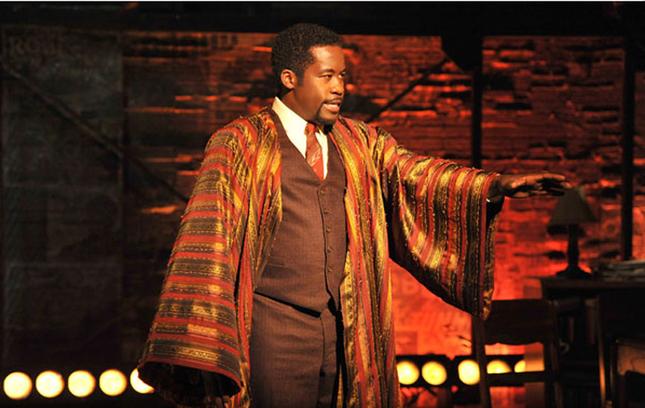‘Tallest Tree’ at Arena: the Grandeur and Range of Paul Robeson
By • January 16, 2015 0 1207

When you look at the length of “The Tallest Tree in the Forest”, the remarkable resurrection play, written and performed by Daniel Beaty in the Kreeger Theatre at Arena Stage—which runs two hours—you think two things at once.
It’s too long. It’s too short.
Beaty—singer, actor, playwright, author, educator—has taken on the task of presenting the remarkable and turbulent character, personality, life and times of Paul Robeson—as singer, actor, athlete, teacher, activist, political figure, and civil rights leader in a biographical piece of theater, densely populated by some 40 characters, all of them played by Beaty.
It’s an exhausting, sometimes steamrollering, experience for an audience, no matter what your level of experiential or personal attachment to the subject at hand. As such, it has the effect of feeling too long.
Yet, it’s also an exhilarating experience. It works as drama and works as a kind of wish that you knew more and want to know more. As a result, it also feels too short.
It’s a daunting task Beaty—who has connected with Arena before as performer and playwright—has set for himself because not only is he playing all the parts, somewhat like an actor doing a one-man “Hamlet”—but he is also portraying a redoubtable, giant figure in American cultural, political and civil rights history. Robeson and his amazing rise, all gifts blazing gloriously, his commitments to social justice for African Americans all in and all the way, require almost equal performance gifts on the part of the actor on stage. He has to have the range to play young Robeson, the great singer Robeson, the philandering Robeson, the roused, courageous and stubborn Robeson and old and dying Robeson.
That life of Robeson’s resonates on the stage during the commemoration of Martin Luther King Jr.’s birthday and the impending celebration of Black History Month. Before there was King and the March on Washington and the heroic, massive changes of the Civil Rights Movement of the 1950s and 1960s, there was Robeson. He himself called himself “the most famous African American in the world.” He was in the vanguard, a huge contradiction of a man, speaking out, singing out and speaking truth to power before there was ever such an imposing voice and man doing so.
Beaty, working with director Moises Kaufman (“The Laramie Project” “The Three Trials of Oscar Wilde”, and “33 Variations” among others) and his edgy Tectonic Theater Company Project, gives us the man in full, if not the total man.
Robeson, one should remember, grew up the son of a minister who was a former slave, was a high school star athlete and student-performer, got a scholarship to Rutgers University and was a football All-American there, became famous for his singing early on during the Harlem Renaissance, starred in two plays by Eugene O’Neill, including “The Emperor Jones,” was the first Jim singing “Old Man River”, took up the cause of civil right, confronted President Harry Truman on anti-lynching laws face to face, fell into the clutches of the House Un-American Activities Committee during the McCarthy era, and ran afoul of FBI Director J. Edgar Hoover for his stubborn embrace of Soviet Union policies.
That doesn’t even include Robeson’s troubled but long marriage to Eslanda “Essie” Goode, whom he married in 1921—she was confidante, manager, lover, wife. The relationship was often quarrelous and wounding. Robeson was a habitual philanderer and had many affairs notably with his Desdemona Uta Hagen in “Othello,” but the couple stayed together.
Somehow, Beaty manages to pull together—if not always in focus—the many strands of Robeson’s overpowering personality and gifts, especially when singing a number of songs that range from “Get on Board Lil’ Chillun’,” “Go Down Moses,” “Great Day,” “Go Down, Moses” and many others. The voice is not necessarily Robeson’s (check out Robeson’s “Ol Man River” on the Web), but it’s supple, more rangy and affective in its own way, striving for the grandeur of Robeson. Nevertheless, it’s in his characterizations that Beaty really shines—we get Truman, civil rights leader Mary Bethune McLeod, who dubbed him “The Greatest Tree in the Forest”—Robeson’s father and others. So effective is in a blistering argument between Robeson and Essie that you feel for her, literally, before you remember that you’re listening to a voice, not seeing a woman.
Robeson—who believed with all his gifts and heart that the artist should be an activist, a fighter against slavery and for freedom and justice —seemed sometimes willfully inclined towards tragedy. His support of Stalin’s Soviet Union even after he discovered that Stalin was murdering and imprisoning Jewish intellectuals goes beyond stubbornness, it’s a clinging to a good principle in defense of evil, a kind of forgiveness he did not apply to his own country. Robeson suffered for his principles as well as mistakes. HIs passport was taken away, thus robbing him of his livelihood singing worldwide. There was a deliberate effort to erase him from history on the part of Hoover and the government.
There are harrowing scenes in this play. His confrontation with Truman on the issue of rising instances of lynching in the South is conducted against a stage background of increasing shadows of men hanging from trees and his interview with a noted Jewish poet in the Soviet Union is a kind of dance of tragic tension.
You walk away with several feelings. You feel the freshness of the material, remember references and music, and wonder from which context members of the audience at any given time are experiencing this resurrection of Paul Robeson. And you walk out feeling, as if you’ve been at a fragmented feast, daunting, but also richer than expected. And you walk away hungry for more.
“The Tallest Tree in the Forest” runs at the Kreeger Theater at Arena Stage through Feb. 16.

